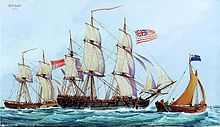During the Siege of Boston, , supplies in the city were short. British Troops were sent out to some of the islands in Boston Harbor to raid farmers for supplies. In response, the colonials began clearing those islands of supplies useful to the British. One of these actions was contested by the British in the Battle of Chelsea Creek, but it resulted in the loss of two British soldiers and the British ship Diana.[1] The need for building materials and other supplies led Admiral Samuel Graves to authorize a Loyalist (American Revolution) merchant to send his ships from Boston to Machias in the District of Maine, accompanied by a Royal Navy schooner. The Machias townspeople rose up, seizing the merchant vessels and then the schooner after a short battle in which its commander was killed. Their resistance and that of other coastal communities led Graves to authorize an expedition of reprisal in October whose sole significant act was the Burning of Falmouth.[2] The outrage in the colonies over this action contributed to the passing of legislation by the Second Continental Congress that established the Continental Navy.[3]
The Second Continental Congress had established the Continental Navy in late 1775.[4] By February 1776 the first ships of the fleet were ready for their maiden voyage, and Commodore Esek Hopkins led a fleet of eight ships on an expedition to the Bahamas, where the British were known to have military stores. In early March, the fleet (reduced by one due to tangled riggings en route) landed marines on the island of New Providence and captured the town of Nassau.[5][6] After loading the fleet's ships, enlarged to include two captured prize ships, with military stores, the fleet sailed north on March 17, with one ship dispatched to Philadelphia, while the rest of the fleet sailed for the Block Island channel.[7] The fleet's cruise was marked by outbreaks of a variety of diseases, including fevers and smallpox, resulting in significant reductions in crew effectiveness.[8]
By April 4 the fleet had reached the waters off Long Island, and captured a prize, the HMS Hawk, which was also laden with supplies. The next day brought a second prize, the Bolton.[9] Hoping to catch more easy prizes, Hopkins continued to cruise off Block Island that night, forming the fleet into a scouting formation of two columns. The right, or eastern, column was headed by the USS Cabot, followed by Hopkins' flagship, the USS Alfred, at 20 guns the largest ship of the fleet, and the left column was headed by the USS Andrew Doria, followed by the USS Columbus. Behind these came the USS Providence, with USS Fly and USS Wasp trailing further behind as escorts for the prizes.[10] The need to provide crews for the prizes further reduced the fighting effectiveness of the fleet's ships.[8]

Although Continental Congress President John Hancock praised Hopkins for the fleet's performance, its failure to capture the Glasgow gave opponents of the Navy in and out of Congress opportunities for criticism. Nicholas Biddle wrote of the action, "A more imprudent, ill-conducted affair never happened."[11] Abraham Whipple, captain of the Columbus, endured rumors and accusations of cowardice for a time, but eventually asked for a court martial to clear his name. Held on May 6 by a panel consisting of officers who had been on the cruise, he was cleared of cowardice, although he was also criticized for errors of judgment.[12] John Hazard, captain of the Providence, was not so fortunate. Charged with a variety of offenses by his subordinate officers, including neglect of duty during the Glasgow action, he was convicted by court martial and forced to surrender his commission.[13]
Commodore Hopkins came under scrutiny from Congress over matters unrelated to this action. He had violated his written orders in sailing to Nassau instead of Virginia and the Carolinas, and he had distributed the goods taken during the cruise to Connecticut and Rhode Island without consulting Congress.[14] He was censured for these transgressions, and dismissed from the Navy in January 1778 after further controversies, including the fleet's failure to sail again (a number of its ships suffered from crew shortages, and also became trapped at Providence, Rhode Island by the British occupation of Newport late in 1776).[15]
- ^ Brooks (1999), p. 108
- ^ Leamon (1995), pp. 67–72
- ^ Miller (1974), p. 49
- ^ Morison, pp. 57–58
- ^ Morison, pp. 67–68
- ^ Field, p. 117
- ^ Field, pp. 118–119
- ^ a b Cite error: The named reference
M44was invoked but never defined (see the help page). - ^ Field, p. 120
- ^ Cite error: The named reference
Morison70was invoked but never defined (see the help page). - ^ Thomas, p. 52
- ^ Morgan, p. 47
- ^ Morgan, pp. 47–48
- ^ Morgan, p. 49
- ^ Morgan, pp. 49–52
- Miller, Nathan (1974). Sea of Glory: The Continental Navy fights for Independence 1775-1783. New York: David McKay. ISBN 9780679503927. OCLC 844299.
- Leamon, James S (1995). Revolution Downeast: The War for American Independence in Maine. University of Massachusetts Press. ISBN 9780870239595.
- Brooks, Victor (1999). The Boston Campaign. Combined Publishing. ISBN 1580970079.
